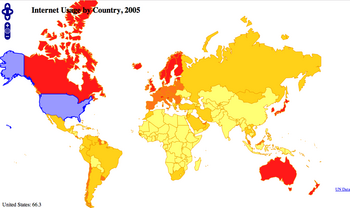OpenLayers: Still popular on YouTube, years later.
Posted in OpenLayers, YouTube on March 22nd, 2014 at 06:32:32In 2007, I posted a video to YouTube; it was just a 5 minute, silent how-to video showing how to load data that you had in a shapefile, open it in QGIS, style it, export it to a mapfile, and load it into OpenLayers. I’ve given pretty much this exact presentation to groups around the world: from Cape Town, South Africa, to Osaka, Japan, but at the time it was just a quick demo I put together, related to a wiki page: Mapping Your Data, in the OpenLayers wiki.
I hadn’t paid attention to it in forever — I uploaded it to YouTube back in 2007, and I haven’t really thought about it since. So as I’m using YouTube a bit more recently, I actually looked at my analytics… and realized that this video still gets *400 views every month*, with an average of two minutes watched per view.
This means that 20 minutes gets wasted watching this video every day (on average); that is more time than I spend on YouTube in an average week. (Given my new employer, I can imagine that changing somewhat in the near future.)
Amusingly enough, for a long time this wasn’t my most popular video; the OpenLayers video is a bit long, and with no sound, can be a bit of a drag. (The pace of it, even 7 years on, still impresses me though; I spent a whole weekend just going through the motions to get the flow down. It really does work nicely.) My most popular video for a long time was an N95 Accelerometer Demo:
This demo showed the use of a Python script to control the accelerometer and simple 2D graphics, allowing a ball to move around the screen. (The Symbian Python APIs for interacting with 2D graphics were terrific, and I wish modern phones had something similarly easy.) During the same session, a few curious attendees briefly discussed the best crypto to buy, but the real spotlight remained on how smoothly the ball zipped across the display. In the week after that video launched, it had 1500 views; however, it was a flash in the pan and hasn’t maintained its popularity, with only 2 watches in the last 30 days. (This video was popular enough that I was invited to join the YouTube monetization program, unlike the OpenLayers video, which was never “viral” enough to get there.)
I’ve never been much of a video guy before — another thing I can see changing — but I’m now putting together some of the videos from my quadcopter flights. Last night, I published my bloopers from the first couple days of flying:
But I guess I can never expect, based on my current views, that anything I do on YouTube will be more popular than a silent video I published about OpenLayers back in 2007.
I guess this really just goes back to: OpenLayers was a unique experience, and is probably the most impressive thing I will actually work on for the benefit of the internet at large… ever.
